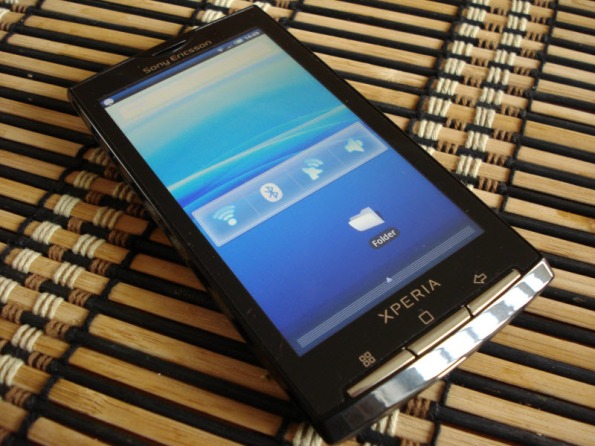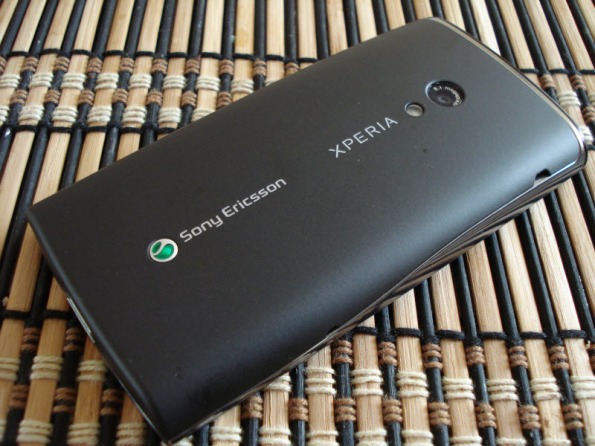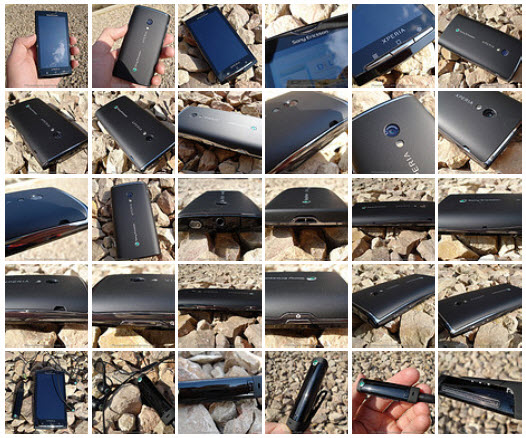Sony Ericsson X10 – Does X mark the Spot?
It’s been quite some time since I’ve had a smartphone on my hands running on Android OS. Since my last visit, the little green robot’s operating system has been rapidly gaining ground and is now picked up by almost all top players in the mobile industry. Moreover, for some (read: Motorola) it has even been the saving grace from being steamrolled by Apple’s cult phone. A quick glance over the latest review headlines and it’s crystal clear the market becomes increasingly saturated with Android devices varying quality and covering different price segments. No doubt, it’s a definitive step forward since the release of G1 a mere two years ago. Now we see this open source platform steadily feeding off Windows Mobile market share and ready to take the leap for Symbian OS that still remains the leading software platform for smartphones.
Sony Ericsson XPERIA X10 unboxing
Now we’re moving closer to the reason of this very story. There’s no denying that Sony Erricsson has been struggling with shrinking sales and , with a troubling launch of their first Symbian smartphone SE Satio behind their back, the situation doesn’t seem to be radically improving for the Swedish- Japanese joint company. It’s crystal clear they are in desperate need of a high seller in the lucrative smartphone segment, something that could potentially succeed where Symbian running Satio or Windows Mobile running Xperia X2 has failed. A natural choice was made to jump for the Android bandwagon, and the inevitable announcement of their first Android smartphone, X10 aka Rachel, followed . Back in November last year, that is.
The device finally hits the store shelves in March or about four months later since it was announced,but there’s no scent of the hype that previously surrounded the new flagship from Sony Ericsson, and a with good reason. Coming out this late, the device quite unceremoniously entered the dogfight with similarly spec’ed smartphones from the well entrenched Android movers Google and HTC. The X10, theoretically, should be able to hold it’s own ground with an enormous 4” screen (only beaten by HTC’s HD2) , 8 Mpix camera, attractive design and a market leading Snapdragon 1 GHz processor under the hood. Google’s Nexus One and HTC Desire, both to be considered the fiercest rivals of the Sony Ericsson’s new baby, sport a newer version of Android. Even more so, the HTC had plenty of time to perfect their Sense UI that brings their smartphones far beyond the stock Android user experience that is found on Xperia X10. Perhaps there’s some reasoning behind the company’s decision to set the sailes on their latest flagship with the oldish Android 1.6 version at the helm, but it’s sure as hell doesn’t make any sense from the consumers standpoint. As it can be guessed, the ensuing problems are deep and run throughout the X10 that to me initially appeared as a very promising new entry in the smartphone market for Sony Ericsson. Yet the product stumbles and it stumbles hard against the very obstacles set by the manufacturer.
The problems of the X10 pain even more so with the realization that SE really had done their homework pretty much elsewhere. The proprietary port has been phased out in favor of everyone’s favorite microUSB connection standard ( that is utilized both for charging and data transfer) while the 3.5 mm port makes a welcome comeback for the music loving crowd’s. The madness, that comes in the form of a 4 inch capacitive touchscreen, is encompassed in a slim and stylish body. The front panel is completely flat and protected by the fingerprint loving, glossy plastic that at first sight promises to be durable enough not the get scratched easily, while the back cover is made of soft matt plastic that ensures the sizable handset won’t accidentally slip out of hands. There’s also an elegantly shaped line of chromed plastic that wraps around the device, making the phone feel solid and more expensive. The X10 sits surprisingly well in hand despite the overwhelming dimensions of the screen, and SE engineers deserve all the kudos for achieving that. My only complaints go as far as the rather sharp edges of the front cover that could get damaged if the user gets a bit careless with his expensive purchase.
(Simply click on the thumbnails to get to the gallery!)
It’s not rare that a refreshing looks demand certain sacrifices in ergonomics and unfortunately, the X10 is no exception. First and foremost, the trio of hardware keys below the display are placed at the very edge of the front cover, which makes single-handed operations with the phone unnecessarily challenging. Oddly enough, the backlight shines through the gaps rather than actually illuminating these keys. My second gripe regarding the usability of the handset is the excessively small camera shutter key, probably to keep it in line with the design. A reassuring moment is that the camera app does support the ‘touch to focus’ feature inherited from other Sony CyberShot camphones.
While the 8.1 megapixel camera module does present some really enjoyable still image results in clear weather conditions outdoors, it also performs predictably bad anywhere else thanks to the inadequately sized LED flash. And with this much power under the hood, you’d think HD video recording would be for granted, and SE would go one step further to exploit the 8.1 Mpix camera and gain a little bit more ground above the competition. But like we learned from the earlier mentioned mishaps that stalk this product, there’re certain things that just doesn’t make much sense from the consumer viewpoint. The X10 is capable of recording videos up to 480×800 or WVGA resolution, a far cry from the 720p videos a lesser spec’ed Sony Ericsson Vivaz can do. I would understand the decision to keep the leading HD recording competency separately in the mid-tier price range, but for a flagship solution this limitation is purely nonsensical. So as much as the taken 8.1 Mpix snapshots impress at times, the one edged camera solution rounds up another feature of X10 that isn’t carried out to it’s fullest potential.
The mono loudspeaker is located on the left side and is decent enough not to miss incoming calls, but you’d have to be really hard pressed to use for leisure like listening to podcasts or music. Speaking about voice calls, I’ve got some people complaining about the poor sound quality, which might be tied to the awkward mic position on the left side of the device. Another trial X10 user and a good friend of mine, @MichaelxHell also confirmed my concerns and I hope this is just another firmware issue waiting to be fixed instead of faulty or ill designed hardware.
While the built materials are certainly up to the pricing level of the phone, the sinister feeling never leaves me that SE desperately tried to cut expenses on the hardware components while making this flagship model. A down to the point example would be the capacitive TFT touchscreen. While it offers a crisp and bright picture with 854 x 480 pixels resolution, and the generous size means little trouble fingering even the smallest UI elements, the screen also comes with it’s own share of drawbacks. The biggest deal breaker for many users is probably the lack of multi-touch support, which is final as the company has already come forward with a ‘hardware limitations’ statement. I was also quite surprised how unresponsive the screen felt at times, it just isn’t as sensitive as you’d come to expect from a capacitive touchscreen that caliber. And finally, the screen operates in 65K colors only, but that in turn is a mere limitation of Android 1.6 rather than hardware. The view angles of the screen are satisfactory, yet in direct sunlight the legibility of the screen is in the same league with AMOLED touchscreen displays and thus leaves a lot to be desired (no pun intended to HTC Desire :P).
As expected, the speedy processor and the spacious screen does take it’s strain on the battery life. The manufacturer was able to fit the X10 with a Li-Po 1500 mAh battery, which under moderate usage means about 1-1,5 days on a single charge. Naturally, having the phone to automatically connect to the web to snatch updates off social networking sites and mailboxes will degrade the battery life even further.
I’ve deliberately left the software review in the very last section of my X10 article. Unfortunately, it’s most likely the biggest tripping point for this device. There’re various scenarios that could develop from here but only one that would ensure SE won’t lose more brand consumers. The device must receive firmware updates asap to address all of the mentioned issues (like the touchscreen sensitivity and call quality), and, better yet, upgrade the OS to Android 2.1 while the device is still breathing. The smartphone market has become increasingly competitive and even the high-end devices running Android now can get overlooked.
And it would be a hard lie to say I’m ready to give up all my hopes with Xperia X10. The unique and eye catching design of X10 is still a very rare attribute to be found in other Android running smartphones. Also it’s worth mentioning that among the very basic set of Android 1.6 apps there’re two noteworthy ones that were developed by Sony Ericsson: MediaScape and TimeScape. The first one has the user’s generated content (like tweets, facebook status updates or captured photos) stacked chronologically in a semi transparent set of cards that you can vertically flick through. Not only that, the list is also populated with updates from other people so it’s an elegant and seamless way to stay up to date with friend’s activities on social networking sites. MediaScape comes with a similarly pleasing interface and sleek animations, but has a more direct role in organizing and providing comfortable access to all media files like music, videos or photos that are stored on the device. It also has integration with PlayNow, which is Sony Ericcson’s own download service offering a wide variety of media content.
Outside those very few trademark moments there’s little else done to distinguish the X10 user experience from the crowd. Perhaps it’s true that with smartphones (backed by an open source application market) the user is free to choose what functionality he truly wants, but the bare bone software package that comes with the X10 might be a reason alone for potential buyers to set their sights elsewhere.
Update: As promised, here’s a camera shootout between 8 Mpix giants Samsung I8910HD and Sony Ericsson Xperia X10. I’ve also included Nokia N900 to the mix (3.5 and 5 Mpix) just to see how it holds up against the competition. All pics are clickable to their original sizes, enjoy!
Objects at medium distance, all settings on auto.
Samsung I8910HD
Sony Ericsson Xperia X10
Nokia N900
Macro mode shoot.
Landscape shoot.
After taking a closer look at the results, it seems like Xperia X10 is a winner here, followed closely by I8910HD, with Nokia N900 bringing up the rear. SE flagship comes forward with deeper, more natural looking colors, although I8910HD deliver rather promising results as well, especially in the macro mode pictures. While the Nokia N900 offered some nice detail on it’s own (taking into account the lowish 3.5 Mpix widescreen resolution), all pics have a rather noticeable green tint to it. Also, it seems like Xperia X10 pics have a much sharper detail on distant objects, just compare the landscape pics!
So in the end, no big surprises here. As I mentioned before, SE Xperia X10 8,1 Mpix camera produces quite stunning shots outdoors, but is rather disappointing anywhere else, thanks to the inadequate LED ‘flash’ performance. Still, X10 has probably the best equipped camera among other Android phones.
One thing I forgot to mention is the absence of camera cover on Xperia X10. The camera lens almost at the same level as the back cover, making it dangerously exposed to scratches and dirt. The situation is even worse than on my Samsung I8910HD , that has the unprotected lens in a slightly deeper aperture (still needs occasional cleaning from the dust before use).
Simply can’t get enough of the Xperia X10 camera brilliance? Here’s an extended album of camera samples for your viewing pleasure!




















Thanks for this review, for it basically summed up my own suspicions of the X10 despite my being tempted to purchase it.
It is truly a shame that Sony Ericsson seems to never learn how to make desirable and competitive models that actually work reliably.
I do have to admit that I was intrigued by the remote accessory in your picture gallery as well as TimeScape.
Thanks! We basically need to wait and see what happens with X10 and whether SE will release a 2.1 update for their flagship or leave it to slowly die like Xperia X2… The X10 is certainly a promising smartphone and many issues can be fixed with software support, but are the potential customers willing to wait that long or simply go for more worked out Android devices like HTC Desire or Nexus One?
No. But now i will. Thanks for that.
I think the Sony Ericsson Xperia X10 is a really great phone, even with Android 1.6, but I am really looking forward to Android 2.1 and Multitouch, as the X10 will be awesome then.
Android 1.6 isn’t so bad on the Sony Ericsson X10, but with Android 2.1 and Multtouch the phone would be a lot better. So I am really looking forward to the update.